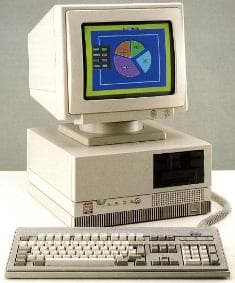Blog Post
UNIX & Linux Ramblings


So How Old is Unix?
47 Years Old!!!
And how old is Windows (Server version)? 23 years old.
UNIX is twice the age of Microsoft Windows (Server version)!
UNIX was first developed in 1969 by AT&T for a DEC PDP platform and throughout the 80s was ported to many different hardware platforms, made possible through licenses to the source code. AT&T also made their source code available to some US universities, one of which was Berkeley University, and they developed their instances of UNIX.
By the mid 80s there were two main variants of UNIX source code available to computer manufacturers:
System V Unix from AT&T
BSD Unix from Berkeley University
All of today’s UNIX implementations are derived from one of these. Virtually identical to the user, but some key differences in the startup/shutdown architecture.
My Trip Down the UNIX Memory Lane!
I first started working with the UNIX Operating System when I was a student at the University of K
ent at Canterbury, way back in the early 80s!! Gosh that makes me feel old!
I remember being sent home for the Easter holidays with a massive pile of folded perforated A3 listing paper (do you remember that stuff?) with the source code of a UNIX operating system printed on it and being told by the lecturer to go home and parse the code! Wow, that was an exciting assignment. I also remember that I had a car accident on the M2 on that journey home – I rolled my Herald estate car – I was fine, but the listing paper ended up billowing across the M2!! Shame!
Anyway back to UNIX. One of the things I love about working with UNIX systems is that fundamentally UNIX doesn’t change. So unlike the Windows world where whenever a new version of Windows is released the look and feel is completely different. I still use commands today that I learnt back in 1982. Throughout the 80s many different variants of UNIX evolved as computer manufacturers adopted UNIX for their server platforms, but even then the architecture of UNIX, the commands, the shell user environment was consistent across them all. Yes, some of the utilities for administering and maintaining the various UNIX derivatives varied, and some of the command options might vary, but at the heart of UNIX is a set of text based configuration files and if you knew your stuff you could administer and manage your UNIX systems by editing configuration files.
Over the years I have worked with a variety of UNIX versions:
SCO Xenix
SCO UNIX
Sun OS
Sun Solaris
IBM AIX
HP HP-UX
Sequent Dynix
Silicon Graphics (SGI) Irix
DEC Ultrix
In the early years of my IT career I worked for a UNIX distributor as a trainer, support engineer and consultant. That exposed me to so many different versions of UNIX and the challenges of installing hardware devices and software applications within various UNIX environments, but the great thing about it was that once you had learnt one version of UNIX the rest were virtually identical!
In the 90s I was a contract trainer to Sequent, Sun and SGI teaching courses at the fundamentals level all the way through to advanced administration, performance & tuning of Dynix, Solaris and Irix. Three different vendors, three different hardware platforms, three sets of volume management services, three sets of multiprocessing hardware implementations, three sets of admin commands, but really…. they were all pretty much the same. The same UNIX shells (Bourne shell, C Shell, Korn Shell, T Shell back then), the same user commands (where would we be without find, grep, sort, sed, awk, tr to name but a few!), the same startup and shutdown architecture (init, /etc/inittab, run levels, run control directories, run control scripts).
Many of the UNIX offerings provided a graphical user environment as well as the command line (I still prefer the command line!!). This was/is known as X Windows. X Windows was not typically implemented on servers – “real” administrators work at the command line!! UNIX could also be installed on to workstations (often diskless) and that is where the X Windows environment was commonly seen – supporting pretty, graphical client applications.
What’s New With Unix?
So 34 years on from my first introduction to UNIX what is new?
Well hardware developed offering more and more power to server platforms. The Intel processor particularly has gone through a massive journey.
I remember one of the first UNIX based networks I worked with consisted of 3 Olivetti M28 computers (286 Intel processor) running SCO Xenix. We used to support 3 users running an Informix Database Application on that one 286 machine!!
Now the Intel chipset is such that we are hosting mainframe type systems on Intel platforms.
New startup and shutdown facilities were introduced, a new startup/shutdown architecture with a services database (more in line with the Windows way of doing things with dependent services). Sun’s version of this is known as SMF. No more inittab file.
Many of the vendors of the 80s and 90s are no longer in existence as hardware manufacturers merged or one took another over. Form example Sequent was taken over by IBM. No more Dynix!
But probably the biggest change in the 90s:
Linux!!!!
Linux Was Born
In the early 90s. Linux was born. Linus Torvalds developed the Linux operating system in 1991. It is a UNIX look alike operating system available for the Intel platform, but was a complete rewrite and was not developed from the main System V or BSD source code.
The objective for the Linux operating system was to develop an Open Source operating system. Open source means that the source code is freely available in the public domain. As a result of this there are now a number of variants of Linux including (to name but a few):
RedHat
CentOS
Suse
Ubuntu
Fedora
Many variants of Linux are available as free software, some such as RedHat Enterprise (RHEL) are available under a license scheme.
Linux v Unix
If you know UNIX , you know Linux. Although a rewrite the same shells and commands are largely available, but with enhanced shells and features added. For example we have the Bash (Born Again) shell. Linux offers X Windows for a graphical user environment.
Linux is seen on servers and workstations. With the power offered by the Intel NUMA architecture Linux is perfect for server platforms hosting applications such as Database Management Systems, Web Servers, and more industry specific application servers. More and more applications are available as Open Source and free for the Linux environment making it more and more attractive and viable for commercial use.
In the early years you had to download the Linux source code, compile the source code and then you could install it onto an Intel based PC. These days most would download a binary version of the Linux software and installing it is much simpler.
I work with Apache on a Linux server. Most of the major Open Source application servers are included with the Linux distribution (MySQL, PostgreSQL, Apache HTTP Server) but these and many more can also be downloaded and installed.
The Open Source World
Working in the world of Open Source software can be challenging. if you stick to the distributions that are provided with Linux distributions then you will generally find it quite straight forward to install, configure and maintain applications servers.
But, the world of Open Source means that you can have much more fun than that!! Open Source software is continually being developed with new versions released. The latest (and older) versions can be downloaded from the relevant open source project websites. Typically this will involve downloading the source code for the software, configuring and compiling an install environment and then installing it.
I have had many a battle with open source software!
Invariably this then leads to issues with missing pre-requisite software, or the wrong version of pre-requisite software and the start of a long, painful and frustrating journey to get everything working successfully. It is, however, very satisfying when you succeed!!
I tend to work with CentOS and RedHat linux. CentOS is essentially the free version of RedHat. They are virtually identical.
What’s New In The Linux World?
Well, Linux keeps moving.
As with the UNIX platforms Red Hat Enterprise 7 and CentOS 7 have seen a major change to the startup and shutdown architecture moving away from the init and /etc/inittab architecture to a new systemd services database architecture.
UNIX Is My First Love
I am so pleased that UNIX is still here today and that Linux evolved to make “UNIX” accessible to all. I far prefer working in a UNIX environment to a Windows environment. I love my command line and the powerful tools such as find, grep and awk that make it possible for me to locate anything, extract anything, display anything.
34 years on I still use UNIX/Linux and I still teach it.
Share This Post
Mandy Doward
Managing Director
PTR’s owner and Managing Director is a Microsoft certified Business Intelligence (BI) Consultant, with over 35 years of experience working with data analytics and BI.
Frequently Asked Questions
Couldn’t find the answer you were looking for? Feel free to reach out to us! Our team of experts is here to help.
Contact Us


